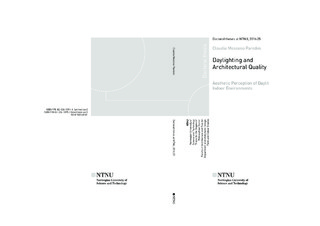| dc.contributor.author | Moscoso, Claudia Paredes | |
| dc.date.accessioned | 2016-02-22T09:43:01Z | |
| dc.date.available | 2016-02-22T09:43:01Z | |
| dc.date.issued | 2016 | |
| dc.identifier.isbn | 978-82-326-1395-3 | |
| dc.identifier.issn | 1503-8181 | |
| dc.identifier.uri | http://hdl.handle.net/11250/2379863 | |
| dc.description.abstract | The present thesis concerns the field of daylighting in architecture. In particular,
this thesis examines the topic of the aesthetic perception of daylit indoor
environments.
Most daylighting studies seem to use photometrical measurements to describe the
light in a space. Moreover, most studies seem to focus on comparing metrics to
establish an adequate illumination for optimal visual and task performance.
However, lighting considerations should go further than merely visual and task
performance guidelines; good lighting should also contribute to the aesthetic
perception of any environment. This is an important distinction to establish: a room
with enough light for performing tasks can be described as an ‘adequately
illuminated room’, whereas a room that also provides a pleasant visual
environment can be considered a ‘well-lit room’. Yet little literature investigating
the aesthetic quality of architectural spaces lit by daylight can be found.
Therefore, the present study seeks to explore how different daylighting designs
affect the aesthetic perception of indoor built environments. The fields of
architecture and daylighting are taken as starting points. In addition, the aesthetic
perception of environments entails studies of environmental psychology, e.g.
environmental aesthetics and measurement of environmental perception. Daylight
and aesthetic quality are thus terms of paramount importance in the present
research. In the scope of the work presented here, two types of daylighting design have been
considered in the study: windows as the most basic daylight collectors in buildings
(primary daylighting design), and daylighting systems as advanced measures to
collect and distribute daylight deeper in interiors (advanced daylighting design). To
examine the aesthetic quality of an architectural space, nine aesthetic attributes
were selected: Pleasantness, Excitement, Order, Complexity, Legibility,
Coherence, Spaciousness, Openness, and Spatial Definition.
Considering that humans spend most of their waking time indoors, and that most of
this time is spent at home and at the workplace, two small environments were the
focus of the presented work: a student room and a single office unit.
Experimental research using a mixed method approach was selected as the research
strategy. Thus, two main experiments were carried out to investigate: i. the effects
of windows on the aesthetic quality of a student room, where three different
window sizes were considered in a room lit under overcast sky conditions; and
ii. the effects of daylighting systems on the aesthetic quality of a small single office, where two types of venetian blinds and two types of light shelves were
considered under overcast sky and clear sky conditions.
The summarised results confirm that daylighting design (within the scope of the
present research; i.e. daylight delivered by windows and/or daylighting systems)
has a significant impact on the aesthetic impression of a small room. Moreover, the
collective findings of the present work suggest that photometric measurements are
not always the perfect predictors to judge the nine selected aesthetic attributes.
Although photometric studies are necessary, other parameters not connected to
lighting metrics (e.g. the location of light patches in the room and the physical and
geometrical characteristics of the daylighting systems) impact the aesthetic
perception of a small room and should be considered.
Furthermore, the study presents a new experimental method that can be used in
daylighting and aesthetics studies. This experimental method is based on the use of
3D or stereoscopic images of environments, taken with two cameras and projected
full-scale on a silver screen. The method was tested in an experimental procedure
and analysed using a method comparison statistical model. The findings show that
stereoscopic imaging is a valid and accurate method for use in daylighting studies.
Daylighting in relation to environmental aesthetics is still an incipient body of
knowledge, as there is still much that we do not know. The aim of the presented
work was set to shed new light on different aspects of daylighting studies, such as
the aesthetics of a lit environment. The presented results provide new knowledge
that could serve as a departure point for the development of new theories and
assumptions that could improve the understanding of this interdisciplinary topic. | nb_NO |
| dc.language.iso | eng | nb_NO |
| dc.publisher | NTNU | nb_NO |
| dc.relation.ispartofseries | Doctoral thesis at NTNU;2016:25 | |
| dc.relation.haspart | Paper 1:
Moscoso, Claudia.
Virtual Environments to study Daylight and Colour. Towards a new approach of advanced research method. I: Nordic Light and Colour 2012. : NTNU - The Faculty of Architecture and Fine Art 2013, s. 95-103 | |
| dc.relation.haspart | Paper 2:
Moscoso, Claudia; Matusiak, Barbara Szybinska; Svensson, U. Peter; Orleanski, Krzysztof.
Analysis of Stereoscopic Images as a New Method for Daylighting Studies. ACM Transactions on Applied Perception 2015 ;Volum 11.(4)
Is not included due to copyright available at
<a href="http://dx.doi.org/ 10.1145/2665078" target="_blank"> http://dx.doi.org/ 10.1145/2665078</a> | |
| dc.relation.haspart | Paper 3:
Moscoso Paredes, Claudia Trinidad; Matusiak, Barbara Szybinska; Svensson, U. Peter.
Impact of window size and room reflectance on the perceived quality of a room. Journal of Architectural and Planning Research 2015 ;Volum 32.(4) s. 294-306 Is not included due to copyright | |
| dc.relation.haspart | Paper 4:
Aesthetic perception of a small room with different daylighting
systems. - Is not included due to copyright | |
| dc.relation.haspart | Paper 5:
Moscoso, Claudia; Matusiak, Barbara Szybinska.
From windows to daylighting systems: How daylight affects the aesthetic perception of architecture. 28th CIE Session | |
| dc.title | Daylighting and Architectural Quality: Aesthetic Perception of Daylit Indoor Environments | nb_NO |
| dc.type | Doctoral thesis | nb_NO |
| dc.subject.nsi | VDP::Humanities: 000::Architecture and design: 140 | nb_NO |

